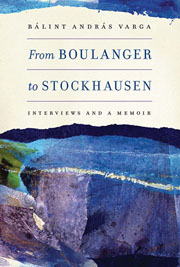Book contents
- Frontmatter
- Dedication
- Contents
- Foreword
- Acknowledgments
- Part One Interviews
- Preface to the Interviews
- Composers
- Conductors
- Instrumentalists
- Alfred Brendel
- Yehudi Menuhin
- Isaac Stern
- Tibor Varga
- Singers and a Record Producer
- A Teacher
- Music Administrators
- Snippets
- Part Two A Memoir
- Notes in Retrospect
- Index
- Miscellaneous Endmatter
Isaac Stern
from Instrumentalists
Published online by Cambridge University Press: 05 January 2014
- Frontmatter
- Dedication
- Contents
- Foreword
- Acknowledgments
- Part One Interviews
- Preface to the Interviews
- Composers
- Conductors
- Instrumentalists
- Alfred Brendel
- Yehudi Menuhin
- Isaac Stern
- Tibor Varga
- Singers and a Record Producer
- A Teacher
- Music Administrators
- Snippets
- Part Two A Memoir
- Notes in Retrospect
- Index
- Miscellaneous Endmatter
Summary
Seated in a stall of the Tonhalle in Zurich on March 8, 1977, I did something very reprehensible indeed: I secretly recorded the first half of a rehearsal, with Isaac Stern playing two short compositions by Mozart for violin and orchestra—the Adagio in E Major KV 261 and the Rondo in C Major KV 373. The Tonhalle Orchestra was conducted by John Pritchard.
Thanks to that misdemeanor, I have now been able to listen yet again to the unique aural phenomenon that was Isaac Stern's violin playing. I closed my eyes, heard the introductory bars of the orchestra—and then, there appeared out of nowhere a bodiless sound illuminated by the halo of Stern's artistry. The sound floated, with ever so slight changes in color and dynamics. It had a sweetness shot through with melancholy, of the kind I had heard in my childhood on historic recordings of Bronisław Huberman and others. I hope I may describe it as noble without appearing to be glib. I was not aware of any vibrato; that the sound was issuing from an instrument, that it was produced by a human being who, as I can still picture him, seemingly did nothing but move his bow up and down, up and down, was a veritable miracle. It was also a miracle what he did with that sound. It was but a means for him to transmit—to use a phrase by Stern himself—Mozart's message.
- Type
- Chapter
- Information
- From Boulanger to StockhausenInterviews and a Memoir, pp. 135 - 143Publisher: Boydell & BrewerPrint publication year: 2013



